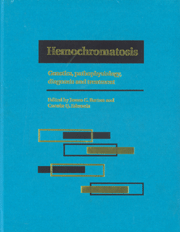Book contents
- Frontmatter
- Contents
- List of contributors
- Foreword
- Part I Introduction to hemochromatosis
- Part II Genetics of hemochromatosis
- Part III Metal absorption and metabolism in hemochromatosis
- Part IV Diagnostic techniques for iron overload
- Part V Complications of iron overload
- Part VI Therapy of hemochromatosis and iron overload
- Part VII Infections and immunity in hemochromatosis
- Part VIII Hemochromatosis heterozygotes
- Part IX Relationship of hemochromatosis to other disorders
- 42 Thalassemias and their interactions with hemochromatosis
- 43 Iron overload in sideroblastic and other nonthalassemic anemias
- 44 Hemochromatosis, iron overload, and porphyria cutanea tarda
- 45 Interactions of alcohol, iron and hemochromatosis
- 46 Iron overload in African Americans
- Part X Animal models of hemochromatosis and iron overload
- Part XI Screening for hemochromatosis
- Part XII Hemochromatosis: societal and ethical issues
- Part XIII Final issues
- Index
43 - Iron overload in sideroblastic and other nonthalassemic anemias
from Part IX - Relationship of hemochromatosis to other disorders
Published online by Cambridge University Press: 05 August 2011
- Frontmatter
- Contents
- List of contributors
- Foreword
- Part I Introduction to hemochromatosis
- Part II Genetics of hemochromatosis
- Part III Metal absorption and metabolism in hemochromatosis
- Part IV Diagnostic techniques for iron overload
- Part V Complications of iron overload
- Part VI Therapy of hemochromatosis and iron overload
- Part VII Infections and immunity in hemochromatosis
- Part VIII Hemochromatosis heterozygotes
- Part IX Relationship of hemochromatosis to other disorders
- 42 Thalassemias and their interactions with hemochromatosis
- 43 Iron overload in sideroblastic and other nonthalassemic anemias
- 44 Hemochromatosis, iron overload, and porphyria cutanea tarda
- 45 Interactions of alcohol, iron and hemochromatosis
- 46 Iron overload in African Americans
- Part X Animal models of hemochromatosis and iron overload
- Part XI Screening for hemochromatosis
- Part XII Hemochromatosis: societal and ethical issues
- Part XIII Final issues
- Index
Summary
Introduction
Iron overload similar to that of hemochromatosis is characteristic of certain forms of anemia. The fundamental mechanisms for accumulation of excess body iron in these disorders appear to be distinct but remain undefined. Chronic anemias characterized by ineffective erythropoiesis are typically associated with iron overload. Rare genetic defects such as atransferrinemia and aceruloplasminemia also lead to unique iron overload patterns of various parenchymal organs and are accompanied by anemia. When hemochromatosis alleles are co-inherited with hereditary hemolytic anemias, the clinical expression of iron overload may be accelerated. Early recognition and treatment of iron accumulation in these disorders prevents irreversible organ damage.
Anemias with ineffective erythropoiesis (iron-loading anemias)
Anemic states characterized by ineffective erythropoiesis are distinguished by defective erythroid maturation and are due to abnormalities in the synthesis of hemoglobin, e.g., thalassemias and sideroblastic anemias, or are due to impaired DNA replication, e.g., megaloblastic and congenital dyserythropoietic anemias. Although increased production of erythropoietin in response to such anemias elicits brisk marrow erythroid hyperplasia, defective erythroblasts are destroyed within the marrow and reticulocytosis is not observed. These features are quantitatively reflected in the ferrokinetic abnormalities of increased plasma iron turnover rate and reduced incorporation of iron into circulating erythrocytes, and in an increased erythropoietic component of the ‘early-label’ bilirubin peak, leading to hyperbilirubinemia and excessive urobilinogen excretion. Erythrocyte survival is normal or slightly reduced, and hemolysis occurs predominantly in the medullary space. In contrast to effective erythropoiesis associated with hemolytic disorders, ineffective erythropoiesis mediates enhanced intestinal absorption of iron in an unknown manner.
- Type
- Chapter
- Information
- HemochromatosisGenetics, Pathophysiology, Diagnosis and Treatment, pp. 442 - 452Publisher: Cambridge University PressPrint publication year: 2000
- 4
- Cited by



